UPDATED REVIEW | November 1, 2025 | Kawai CA501 Review | Digital Piano | LOW PRICE HERE! | All wooden key action and stereo acoustic grand piano sound | The Kawai CA501 furniture cabinet digital piano discount priced at $4099 has become a very popular model.
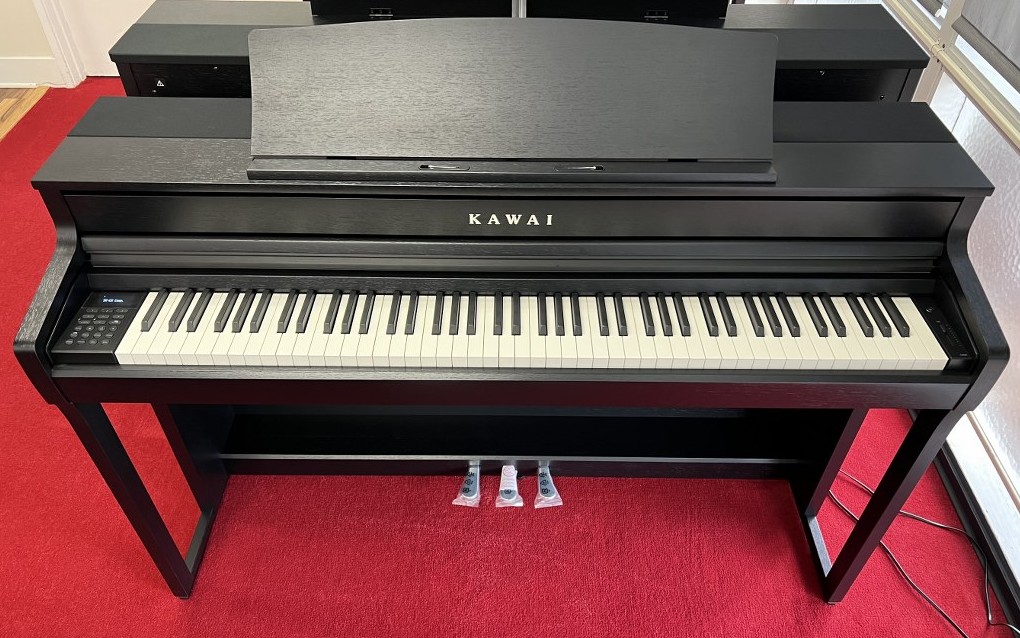
The Kawai CA501 definitely qualifies as a more premium digital piano because it has all the attributes of this type of instrument. It has what I consider to be an attractive cabinet along with the functions and features that would make this piano something you could own for a very long time. If your goal is to get a digital piano which you can “grow into” instead of “grow out of,” then this model would definitely meet that criteria.
The main reasons for this in my opinion, besides having a nicely designed and constructed cabinet, is the fact that it plays and sounds more like an actual acoustic piano than any other digital piano for the same price or for less money. This conclusion is based on my extensive experience playing this model along with the other top brands in this price range.


KEY ACTION
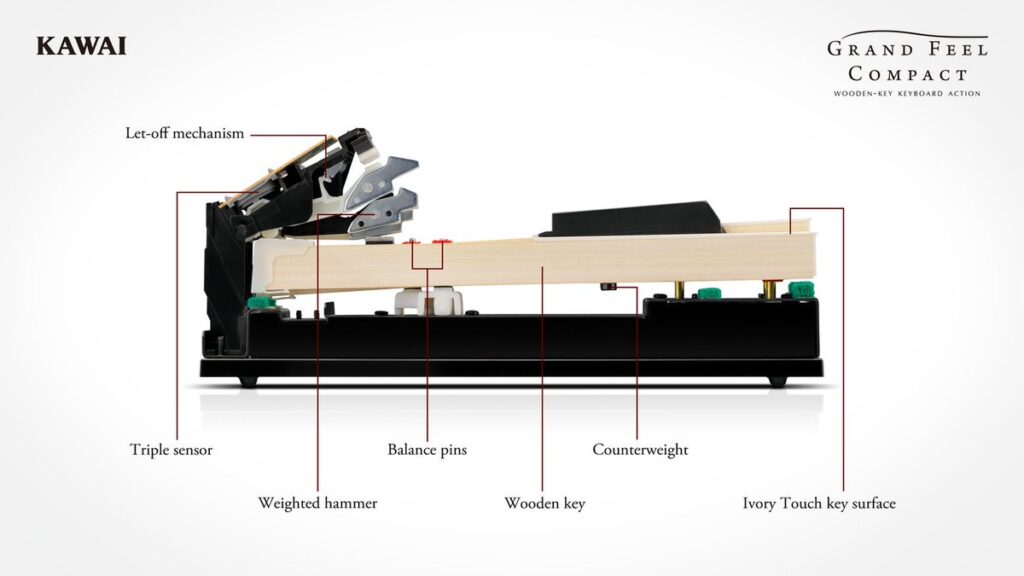
The actual keys in the CA501 are 100% wood. Having both black & white keys in a digital piano made out of 100% wood is very unusual and no other brand offers all wooden keys in the “under $4000 price range.” Beyond the 88 keys being all wood, the full length of the white keys is 12″ long which is much longer and more realistic in that way as compared to any other digital piano from any other brand in the price range.
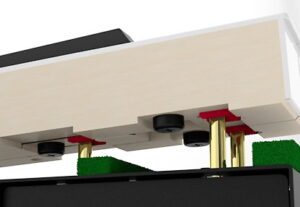 With longer 12″ white keys you are getting much closer to the key length of a real acoustic piano. Longer keys help give a better balance to the key movement when playing towards the front of the keys or towards the back of the keys. When I played the keys on this model I could instantly feel the difference compared to other digital pianos and the key movement response was very impressive. The keys are not only graded & weighted correctly, the bass notes have counter-weights in them for better response because bass note keys are a bit heavier and the key response down there is more accurate with these built-in counter-weights in the keys.
With longer 12″ white keys you are getting much closer to the key length of a real acoustic piano. Longer keys help give a better balance to the key movement when playing towards the front of the keys or towards the back of the keys. When I played the keys on this model I could instantly feel the difference compared to other digital pianos and the key movement response was very impressive. The keys are not only graded & weighted correctly, the bass notes have counter-weights in them for better response because bass note keys are a bit heavier and the key response down there is more accurate with these built-in counter-weights in the keys.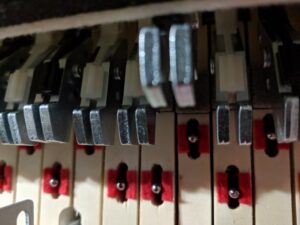 In most digital pianos, key actions are generally installed in a metal chassis and each key is put in without being stabilized through the center of the key like acoustic piano key actions are. In the Kawai CA501, Kawai uses an acoustic stabilizer pin that is put through the center of the key which helps prevent “side to side” lateral key movement. This metal pin is permanent and also gives each key more stability so that the keys don’t shift when you are playing them.
In most digital pianos, key actions are generally installed in a metal chassis and each key is put in without being stabilized through the center of the key like acoustic piano key actions are. In the Kawai CA501, Kawai uses an acoustic stabilizer pin that is put through the center of the key which helps prevent “side to side” lateral key movement. This metal pin is permanent and also gives each key more stability so that the keys don’t shift when you are playing them. The “weight” of the keys is very important in terms of key movement and response, as well as comfort when playing. Comfort when playing is important because you don’t want your hands, fingers, wrists, and forearms to become fatigued when you are playing, especially when playing long periods of time. Playing music for most people is recreational and not competitive such as advanced classical performances on a grand piano.
The “weight” of the keys is very important in terms of key movement and response, as well as comfort when playing. Comfort when playing is important because you don’t want your hands, fingers, wrists, and forearms to become fatigued when you are playing, especially when playing long periods of time. Playing music for most people is recreational and not competitive such as advanced classical performances on a grand piano.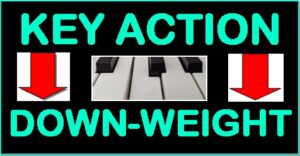 The down-weight (aka: touch-weight) force on middle C white key when initialing key movement and pressing down on the key is at about 55 grams based on my measurements. In fact, the key actually started to move at about 48 to 50 grams (which is good) but was more noticeable at 55 grams when pressing down the key on middle C. In my opinion this touch-weight is just about perfect for piano playing when it comes to fast key movement response along with a very comfortable playing experience when pressing down on the keys. On the middle C# (black) key the touch weight is approx 53 grams which is also very good and is balanced well against the white C key.
The down-weight (aka: touch-weight) force on middle C white key when initialing key movement and pressing down on the key is at about 55 grams based on my measurements. In fact, the key actually started to move at about 48 to 50 grams (which is good) but was more noticeable at 55 grams when pressing down the key on middle C. In my opinion this touch-weight is just about perfect for piano playing when it comes to fast key movement response along with a very comfortable playing experience when pressing down on the keys. On the middle C# (black) key the touch weight is approx 53 grams which is also very good and is balanced well against the white C key.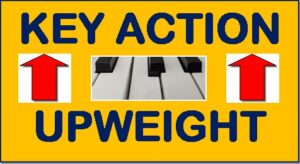 The upweight force of the middle C key when coming back up after pressing it down is approx 37 grams of force which is responsive but yet comfortable. I have played top name digital pianos that have a slow and sluggish upweight and I have also played top name digital pianos with an upweight return key force at about 45 grams or more which can be somewhat too strong (too much force when the key comes back up), especially when you are at more beginner through intermediate skill levels.
The upweight force of the middle C key when coming back up after pressing it down is approx 37 grams of force which is responsive but yet comfortable. I have played top name digital pianos that have a slow and sluggish upweight and I have also played top name digital pianos with an upweight return key force at about 45 grams or more which can be somewhat too strong (too much force when the key comes back up), especially when you are at more beginner through intermediate skill levels.MORE KEY ACTION FEATURES
 In addition to the all the features I have already mentioned concerning the key action, Kawai has a couple more things they include to make the key action a bit more authentic. One of those features is called “let-off” (aka: escapement). The let-off features tries to simulate what the action movement feels like in a grand piano when you press down the keys. The a white key is depressed about half way down, there is a slight hesitation in the key movement which is also known as a “notch” where the action engages a movement that is supposed to give you more key control when playing lightly.
In addition to the all the features I have already mentioned concerning the key action, Kawai has a couple more things they include to make the key action a bit more authentic. One of those features is called “let-off” (aka: escapement). The let-off features tries to simulate what the action movement feels like in a grand piano when you press down the keys. The a white key is depressed about half way down, there is a slight hesitation in the key movement which is also known as a “notch” where the action engages a movement that is supposed to give you more key control when playing lightly.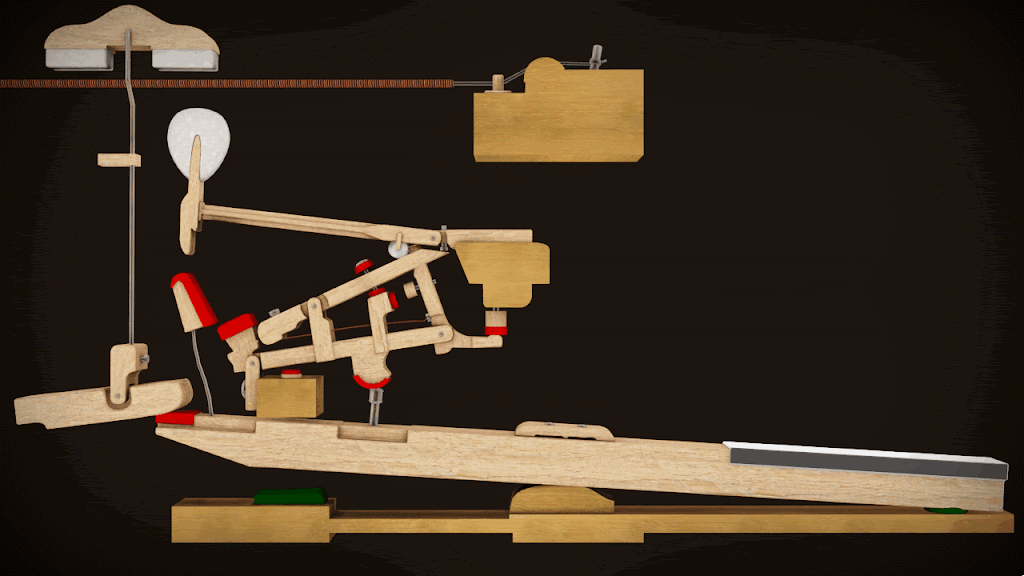 You would only feel this “let-off” effect when playing lightly on a real grand piano and not when you are playing faster with more force. The let-off simulation that Kawai has in this CA501 is actually pretty good and does give you that feeling that it is happening. But…whether or not this feature is necessary is something that I feel is very subjective. You can definitely live without it but for some people they will be glad it’s there, especially if they have played real grand pianos before and are sensitive to it.
You would only feel this “let-off” effect when playing lightly on a real grand piano and not when you are playing faster with more force. The let-off simulation that Kawai has in this CA501 is actually pretty good and does give you that feeling that it is happening. But…whether or not this feature is necessary is something that I feel is very subjective. You can definitely live without it but for some people they will be glad it’s there, especially if they have played real grand pianos before and are sensitive to it.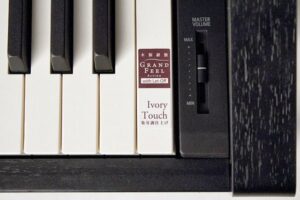 The last thing I want to mention in this Kawai CA501 review about the CA501 key action is the material they put on the tops of the keys. Kawai has designed a proprietary material that reproduces the “feel” and properties of ivory and ebony that were used many decades ago on real acoustic pianos. The organic ivory that came from elephants and organic ebony that came from actual ebony trees were put on the key tops to help absorb sweat from the fingers and also make the keys look less shiny and plastic.
The last thing I want to mention in this Kawai CA501 review about the CA501 key action is the material they put on the tops of the keys. Kawai has designed a proprietary material that reproduces the “feel” and properties of ivory and ebony that were used many decades ago on real acoustic pianos. The organic ivory that came from elephants and organic ebony that came from actual ebony trees were put on the key tops to help absorb sweat from the fingers and also make the keys look less shiny and plastic.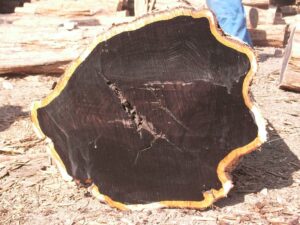 Almost all of the major digital piano manufacturers now put a synthetic version of the ivory and ebony on some of their models but each manufacturer does it differently and some are not as good as others. When it comes to the Kawai digital pianos that have this synthetic material on the keytops of some of their models, in my opinion Kawai has found the right balance between smoothness and a bit of texture for this material so that it look attractive, helps absorb sweat from the fingers, feels good to the fingers, and gives you the feeling that you are touching real ivory and ebony.
Almost all of the major digital piano manufacturers now put a synthetic version of the ivory and ebony on some of their models but each manufacturer does it differently and some are not as good as others. When it comes to the Kawai digital pianos that have this synthetic material on the keytops of some of their models, in my opinion Kawai has found the right balance between smoothness and a bit of texture for this material so that it look attractive, helps absorb sweat from the fingers, feels good to the fingers, and gives you the feeling that you are touching real ivory and ebony.STEREO GRAND PIANO SOUND SAMPLES
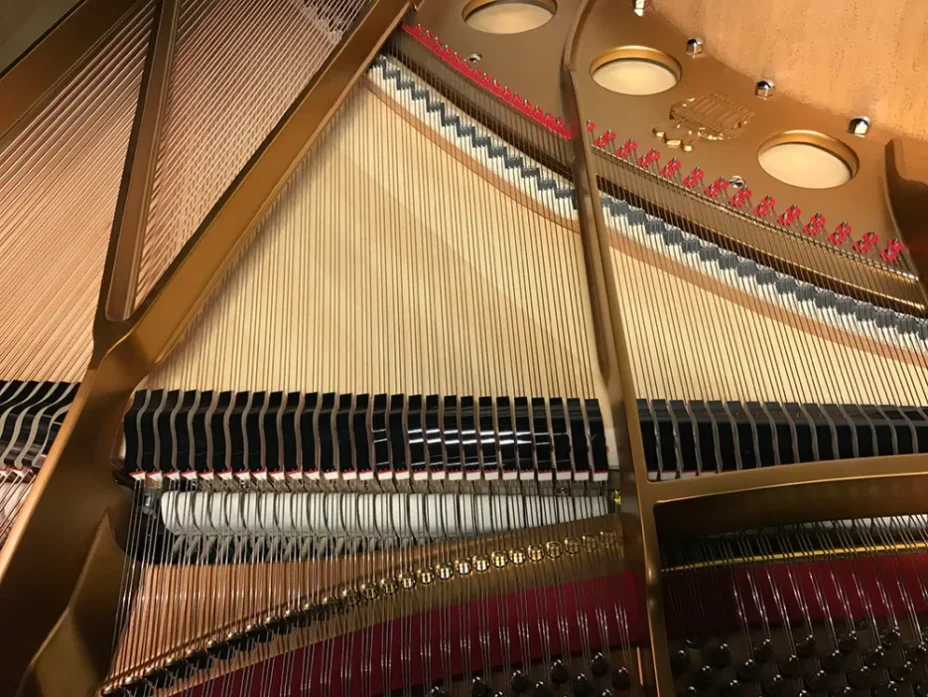
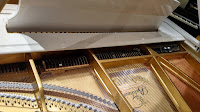 The piano sound is really very complex and there are over 200 strings in each 88-key acoustic piano. There may be 88 keys on a piano, but there are really about 2 1/2 times as many individual strings in that same acoustic piano, believe it or not. All these strings create all these different sound waves, frequencies, and organic tonal elements including the hammers and how they move and how they strike the strings in a real acoustic piano along with how the sound waves resonate in and through a wood soundboard in a real acoustic piano.
The piano sound is really very complex and there are over 200 strings in each 88-key acoustic piano. There may be 88 keys on a piano, but there are really about 2 1/2 times as many individual strings in that same acoustic piano, believe it or not. All these strings create all these different sound waves, frequencies, and organic tonal elements including the hammers and how they move and how they strike the strings in a real acoustic piano along with how the sound waves resonate in and through a wood soundboard in a real acoustic piano.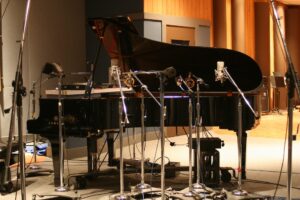 Just doing a sampled recording of a single piano string is not near enough to recreate an authentic piano sound in a digital piano. It takes a very sophisticated digital technology to make that happen for a digital piano along with how that piano sound is recorded from a real acoustic piano, how many and what quality microphones are used to do that piano sound recording in a good acoustic grand piano, the room it was recorded in, how good the original piano was tuned by an expert piano tuner, etc, etc.
Just doing a sampled recording of a single piano string is not near enough to recreate an authentic piano sound in a digital piano. It takes a very sophisticated digital technology to make that happen for a digital piano along with how that piano sound is recorded from a real acoustic piano, how many and what quality microphones are used to do that piano sound recording in a good acoustic grand piano, the room it was recorded in, how good the original piano was tuned by an expert piano tuner, etc, etc. The Kawai company is first and foremost an acoustic piano company founded almost 100 years ago in Japan and all they make is acoustic and digital pianos. They are a privately held company by the Kawai family for all that time. Their pianos are played by leading concert artists, musicians, piano teachers, universities, schools, recording studios, and families throughout the world. They have a great reputation for building fine pianos and have some of the best digital piano technology out there. In other words, based on my playing experience with their instruments, they know what they’re doing.
The Kawai company is first and foremost an acoustic piano company founded almost 100 years ago in Japan and all they make is acoustic and digital pianos. They are a privately held company by the Kawai family for all that time. Their pianos are played by leading concert artists, musicians, piano teachers, universities, schools, recording studios, and families throughout the world. They have a great reputation for building fine pianos and have some of the best digital piano technology out there. In other words, based on my playing experience with their instruments, they know what they’re doing. To add to the realism of the acoustic piano sounds in this new model, Kawai has something they call the “competition grand piano” sound. This new grand piano “sample” is beyond previous Kawai digital pianos because of the upgraded technology that Kawai is using to produce this new “competition” grand piano sound along with the type of new stereo microphones and positioning of those microphones during the recording sessions where they record those piano sounds into the CA501 sound engine.
To add to the realism of the acoustic piano sounds in this new model, Kawai has something they call the “competition grand piano” sound. This new grand piano “sample” is beyond previous Kawai digital pianos because of the upgraded technology that Kawai is using to produce this new “competition” grand piano sound along with the type of new stereo microphones and positioning of those microphones during the recording sessions where they record those piano sounds into the CA501 sound engine.KEYBOARD TOUCH SETTINGS
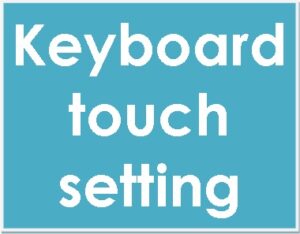 Most digital pianos have a feature that allows you to digitally change the touch when you play the keys. It does not actually change the physical weight of the key but instead it makes the piano sound come in quicker or less quick when you press the key down. In other words, if you pressed the key down lightly but you wanted to have the piano sound come in louder than normal then you would put the touch sensitivity on the “light” setting.
Most digital pianos have a feature that allows you to digitally change the touch when you play the keys. It does not actually change the physical weight of the key but instead it makes the piano sound come in quicker or less quick when you press the key down. In other words, if you pressed the key down lightly but you wanted to have the piano sound come in louder than normal then you would put the touch sensitivity on the “light” setting.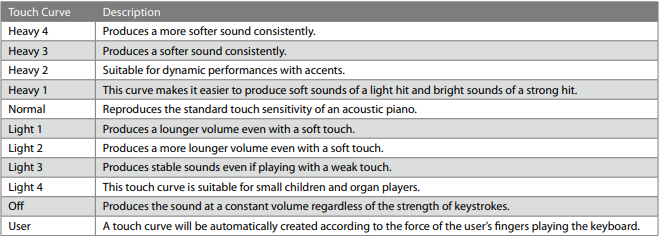
PIANO & INSTRUMENT SOUNDS

Not only does the new CA501 have this new “competition” grand piano sound, but it also has a big library of additional grand and upright acoustic piano sounds which I have played and are also impressive. These additional acoustic piano sounds come from other top model Kawai grand piano & upright pianos and are professionally sampled and recorded directly from the actual Kawai acoustic pianos and done in a pro recording studio.

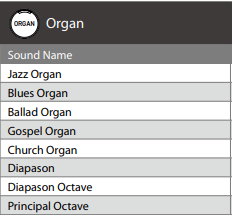
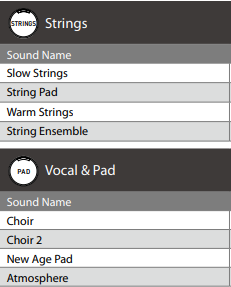
PIANO “SMART MODE”

 OK, there is one more thing for me to talk about with regard to using the grand & upright piano sounds in the CA501. Kawai has an additional piano sound feature called “Smart Mode” settings. I already talked about the “Virtual Technician” parameters that allow you to individually adjust the many organic aspects of the piano sound and that’s a useful tool to have, especially if you are a bit more “daring” and comfortable with doing those things.
OK, there is one more thing for me to talk about with regard to using the grand & upright piano sounds in the CA501. Kawai has an additional piano sound feature called “Smart Mode” settings. I already talked about the “Virtual Technician” parameters that allow you to individually adjust the many organic aspects of the piano sound and that’s a useful tool to have, especially if you are a bit more “daring” and comfortable with doing those things.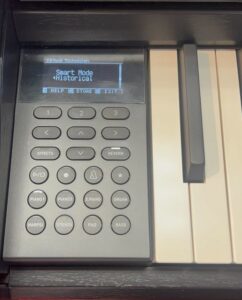 This is so that you don’t have to adjust individual parameters in the Virtual Technician feature, but instead you just go to the Piano Sound “Smart Mode” and select any of the factory presets and the CA501 automatically adds or subtracts tonal elements of the piano sound you have selected among the 13 piano sounds in the CA501.
This is so that you don’t have to adjust individual parameters in the Virtual Technician feature, but instead you just go to the Piano Sound “Smart Mode” and select any of the factory presets and the CA501 automatically adds or subtracts tonal elements of the piano sound you have selected among the 13 piano sounds in the CA501. You would have the choices of just picking any piano sound out of the 13 piano sample recordings that Kawai provides in the CA501 and just playing that sound “as is.” Or, if you wanted to “tweak” that sound a bit to get it more suited to your ears, you could do that with the Virtual Technician, one parameter at a time, or you could use the “Smart Mode” that has a number of preset settings that have already been done by the factory pianists to add even more realism and enjoyment to the piano sound you selected.
You would have the choices of just picking any piano sound out of the 13 piano sample recordings that Kawai provides in the CA501 and just playing that sound “as is.” Or, if you wanted to “tweak” that sound a bit to get it more suited to your ears, you could do that with the Virtual Technician, one parameter at a time, or you could use the “Smart Mode” that has a number of preset settings that have already been done by the factory pianists to add even more realism and enjoyment to the piano sound you selected.TOPBOARD “LID” POSITION
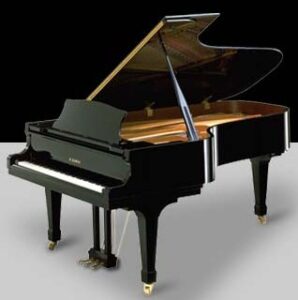 One final thing about the piano sound. Real grand pianos have “lids” (aka: tops). You can lift up the lid to a full height position which allows for the most piano sound to come out of the piano. That’s how grand pianos normally look…with the lid fully open. You can also lower the lid to half-height position to reduce the volume of the sound along with that reduced lid height making the piano sound somewhat less bright. You also have the option of closing the lid all the way so that it lies flat on the piano. This reduces the volume even further and also makes the sound more muted and mellow.
One final thing about the piano sound. Real grand pianos have “lids” (aka: tops). You can lift up the lid to a full height position which allows for the most piano sound to come out of the piano. That’s how grand pianos normally look…with the lid fully open. You can also lower the lid to half-height position to reduce the volume of the sound along with that reduced lid height making the piano sound somewhat less bright. You also have the option of closing the lid all the way so that it lies flat on the piano. This reduces the volume even further and also makes the sound more muted and mellow.
PIANO POLYPHONY
 In the digital piano specifications there is something known as “polyphony” which is another name for piano processing power. The more polyphony a digital piano has, generally speaking, the better. But a primary purpose for having more polyphony as opposed to less polyphony is to be able to play more complex music with a more complex and upgraded stereo piano sound while also using the sustain/damper pedal at the same time. With more polyphony piano processing, you would be able to play at advanced skill levels with the notes being more natural in sound and performance.
In the digital piano specifications there is something known as “polyphony” which is another name for piano processing power. The more polyphony a digital piano has, generally speaking, the better. But a primary purpose for having more polyphony as opposed to less polyphony is to be able to play more complex music with a more complex and upgraded stereo piano sound while also using the sustain/damper pedal at the same time. With more polyphony piano processing, you would be able to play at advanced skill levels with the notes being more natural in sound and performance. In the CA501 Kawai has 256-notes of polyphony which is the most that is offered in any of the Kawai digital piano models as well as in other digital piano brands such as Yamaha and Casio. Having 256-notes of polyphony is more than enough and allows you to play at any piano skill level any type of music. In the old days years ago, the amount of polyphony in digital pianos used to be 8 notes mono, then 16 notes, then 24 notes, 32 notes, and so on. At one time when there was an increase to 64-notes from 32 notes of polyphony piano memory, everyone thought that was amazing!
In the CA501 Kawai has 256-notes of polyphony which is the most that is offered in any of the Kawai digital piano models as well as in other digital piano brands such as Yamaha and Casio. Having 256-notes of polyphony is more than enough and allows you to play at any piano skill level any type of music. In the old days years ago, the amount of polyphony in digital pianos used to be 8 notes mono, then 16 notes, then 24 notes, 32 notes, and so on. At one time when there was an increase to 64-notes from 32 notes of polyphony piano memory, everyone thought that was amazing!PIANO PEDALS
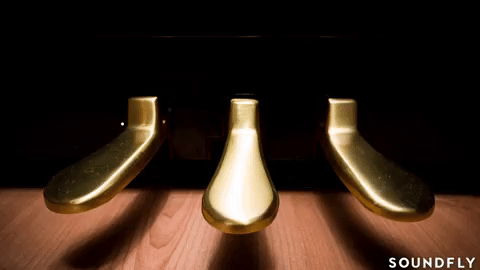 Pedals on any piano are important, especially when you are advancing in your piano playing skills or you already know how to play well. There are obviously 3 pedals on real acoustic pianos, and furniture cabinet digital piano are the same way. There is the right sustain/damper pedal (the most important one), the middle sostenuto pedal (the least important one), and the left soft pedal. However, the way these pedals function on acoustic pianos vs digital pianos are different from each other. Acoustic piano pedals work in a mechanical way and those pedals trigger mechanical parts on the inside of the piano to do certain things that will affect the piano sound.
Pedals on any piano are important, especially when you are advancing in your piano playing skills or you already know how to play well. There are obviously 3 pedals on real acoustic pianos, and furniture cabinet digital piano are the same way. There is the right sustain/damper pedal (the most important one), the middle sostenuto pedal (the least important one), and the left soft pedal. However, the way these pedals function on acoustic pianos vs digital pianos are different from each other. Acoustic piano pedals work in a mechanical way and those pedals trigger mechanical parts on the inside of the piano to do certain things that will affect the piano sound.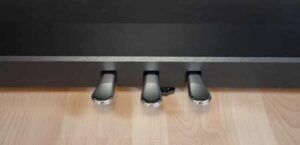 In a digital piano the pedals try to recreate that pedal piano sound experience, but there are no mechanical parts in a digital piano like there are in real acoustic pianos, so that’s a big difference and there are some mechanical things that pedals do that generally cannot be reproduced in a digital piano. But apart from the mechanical differences, the end result is that for most people the pedals on digital pianos will do what pedals are supposed to do.
In a digital piano the pedals try to recreate that pedal piano sound experience, but there are no mechanical parts in a digital piano like there are in real acoustic pianos, so that’s a big difference and there are some mechanical things that pedals do that generally cannot be reproduced in a digital piano. But apart from the mechanical differences, the end result is that for most people the pedals on digital pianos will do what pedals are supposed to do. But nevertheless, different models and brands of digital pianos can vary from each other when it comes to the quality of the pedals, the mechanical noise those pedals will produce when those pedals go up & down, the “feeling” of those pedals when your foot presses them down, and ultimately the piano sounds that are produced when you are using the pedals.
But nevertheless, different models and brands of digital pianos can vary from each other when it comes to the quality of the pedals, the mechanical noise those pedals will produce when those pedals go up & down, the “feeling” of those pedals when your foot presses them down, and ultimately the piano sounds that are produced when you are using the pedals.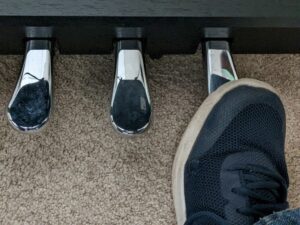 They may look like pedals on the outside, but apart from that, those cheaper pedals on no-name brands of digital pianos don’t work well, they don’t make the piano sound good like pedals are supposed to do, and those pedals just don’t work right. So when you see 3 attached pedals near the bottom of a digital piano cabinet, just know they are not all the same just like tires are not all the same on vehicles. Pedals are very important in how they move when you press them down with your feet, if they make a lot of mechanical noise, and what those pedals do to your piano sound.
They may look like pedals on the outside, but apart from that, those cheaper pedals on no-name brands of digital pianos don’t work well, they don’t make the piano sound good like pedals are supposed to do, and those pedals just don’t work right. So when you see 3 attached pedals near the bottom of a digital piano cabinet, just know they are not all the same just like tires are not all the same on vehicles. Pedals are very important in how they move when you press them down with your feet, if they make a lot of mechanical noise, and what those pedals do to your piano sound. There are always differences in quality among the better brands of digital pianos, but I do like the Kawai CA501 Grand Feel Pedals very much. This is because they feel good when you press them down, they offer the control you need with regard to the right sustain/damper pedal levels, the left pedal for soft sound pedaling, and the middle pedal sostenuto response…and they are mechanically quiet when they move. In fact the right sustain pedal offers a long sustain-decay time which is great (many sustain pedals don’t do this) along with being able to trigger the half-damper sustain effect which is important.
There are always differences in quality among the better brands of digital pianos, but I do like the Kawai CA501 Grand Feel Pedals very much. This is because they feel good when you press them down, they offer the control you need with regard to the right sustain/damper pedal levels, the left pedal for soft sound pedaling, and the middle pedal sostenuto response…and they are mechanically quiet when they move. In fact the right sustain pedal offers a long sustain-decay time which is great (many sustain pedals don’t do this) along with being able to trigger the half-damper sustain effect which is important.SPECIAL EFFECTS & REVERB
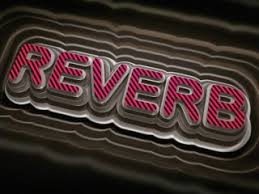 Built-in “special effects” in a digital piano can be useful because they can help “liven up” the piano and instrument sounds in ways that may add to the overall realism of that sound. For instance, if you were playing a real acoustic piano or other instruments in a small room, then there would be a certain amount of natural “reverb/echo” in that room so the sound would be a bit more “alive” rather than be just more plain and dry. Natural reverb is all around us and the bigger the room we are in, then the more reverb there is, especially if there is little or no sound absorbing material in that room.
Built-in “special effects” in a digital piano can be useful because they can help “liven up” the piano and instrument sounds in ways that may add to the overall realism of that sound. For instance, if you were playing a real acoustic piano or other instruments in a small room, then there would be a certain amount of natural “reverb/echo” in that room so the sound would be a bit more “alive” rather than be just more plain and dry. Natural reverb is all around us and the bigger the room we are in, then the more reverb there is, especially if there is little or no sound absorbing material in that room.
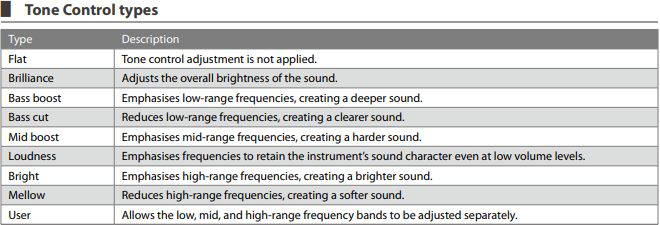
 Another cool feature is being able to alter and edit the tonal frequencies (aka: EQ) of the CA501 to add more or less bass, mid-range, and treble frequencies to your overall sound. Kawai calls this feature “Tone Control Types.” Everyone’s ears are different and we hear sound frequencies differently. To have a more customized “listening experience” you can easily and quickly adjust these tonal frequencies in the CA501 (see chart above) to make your listening experience more enjoyable to your ears in that way.
Another cool feature is being able to alter and edit the tonal frequencies (aka: EQ) of the CA501 to add more or less bass, mid-range, and treble frequencies to your overall sound. Kawai calls this feature “Tone Control Types.” Everyone’s ears are different and we hear sound frequencies differently. To have a more customized “listening experience” you can easily and quickly adjust these tonal frequencies in the CA501 (see chart above) to make your listening experience more enjoyable to your ears in that way.
OTHER DIGITAL FEATURES & FUNCTIONS
 The CA501 has many more functions & features than what I have already talked about, and these next features can be very useful. Like most other digital pianos in this price range this piano also has the ability to layer/mix and split 2 different sounds at the same time, you can transpose to any key with a transpose/key change feature for live play and also separately transpose any recording you have done to any new key for playback in that key. The transpose feature is great for modulating a song as well as getting it in the vocal range of someone who might be singing along. The CA501 also has an adjustable digital metronome to help with timing and that is especially useful for beginners.
The CA501 has many more functions & features than what I have already talked about, and these next features can be very useful. Like most other digital pianos in this price range this piano also has the ability to layer/mix and split 2 different sounds at the same time, you can transpose to any key with a transpose/key change feature for live play and also separately transpose any recording you have done to any new key for playback in that key. The transpose feature is great for modulating a song as well as getting it in the vocal range of someone who might be singing along. The CA501 also has an adjustable digital metronome to help with timing and that is especially useful for beginners. When it comes to piano playing education, in this Kawai CA501 review I noticed the CA501 has hundreds of popular piano lesson and finger exercise songs in it that go along with famous teacher approved lesson/song books which you can purchase separately from any on-line or local music store. This music library is really helpful and it’s a lot of fun to be able to hear and play along with these lesson songs and finger exercises and see the music that you are playing with from the optional books. It’s a great resource and tool for beginner children through adults and also for different skill levels.
When it comes to piano playing education, in this Kawai CA501 review I noticed the CA501 has hundreds of popular piano lesson and finger exercise songs in it that go along with famous teacher approved lesson/song books which you can purchase separately from any on-line or local music store. This music library is really helpful and it’s a lot of fun to be able to hear and play along with these lesson songs and finger exercises and see the music that you are playing with from the optional books. It’s a great resource and tool for beginner children through adults and also for different skill levels.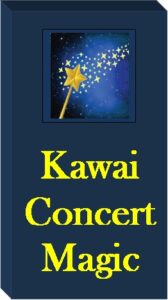 For absolute beginners Kawai has a digital song and rhythm teacher system called “Concert Magic” which allows you to play and hear 176 popular pre-programmed songs that most people will know and you don’t have to know anything about playing piano to use it. You just play any key on the piano and the song will play correctly and keep going as long as you keep pressing any key. The goal is to get “instant gratification” in hearing the song play correctly while you press keys.
For absolute beginners Kawai has a digital song and rhythm teacher system called “Concert Magic” which allows you to play and hear 176 popular pre-programmed songs that most people will know and you don’t have to know anything about playing piano to use it. You just play any key on the piano and the song will play correctly and keep going as long as you keep pressing any key. The goal is to get “instant gratification” in hearing the song play correctly while you press keys.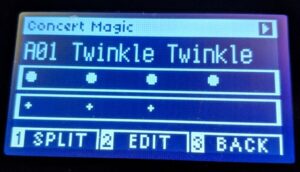 Kawai is the only brand that has this creative and useful Concert Magic piano learning tool and it really sounds good…especially when you see a 2 or 3 year old child do it…very entertaining as well! This feature shows up in the user interface display screen of the piano and there are helpful “prompts” that you can see in the display screen which help you play “in time” with the songs. Also, the volume of the songs changes depending on how hard or soft you strike any key so that you can put in your own musical expression in that way. Just a very cool learning tool and also fun for experienced players as well.
Kawai is the only brand that has this creative and useful Concert Magic piano learning tool and it really sounds good…especially when you see a 2 or 3 year old child do it…very entertaining as well! This feature shows up in the user interface display screen of the piano and there are helpful “prompts” that you can see in the display screen which help you play “in time” with the songs. Also, the volume of the songs changes depending on how hard or soft you strike any key so that you can put in your own musical expression in that way. Just a very cool learning tool and also fun for experienced players as well.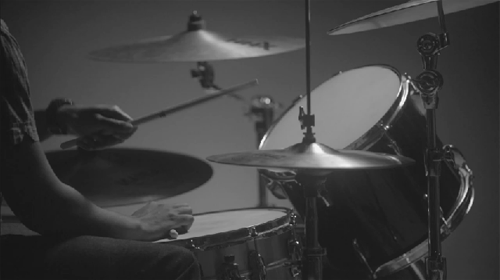 Kawai also has 100 built-in drum rhythm patterns that help you with your rhythm & timing. Rhythm & timing is the most difficult thing in music to learn besides reading music, but it’s the most important thing when playing a song correctly along with feeling & expression. In addition to the other rhythm & timing features this model has, the CA501 also offers actual drum rhythm patterns that you would hear in a band or orchestra in a variety of styles, genres, and time signatures.
Kawai also has 100 built-in drum rhythm patterns that help you with your rhythm & timing. Rhythm & timing is the most difficult thing in music to learn besides reading music, but it’s the most important thing when playing a song correctly along with feeling & expression. In addition to the other rhythm & timing features this model has, the CA501 also offers actual drum rhythm patterns that you would hear in a band or orchestra in a variety of styles, genres, and time signatures.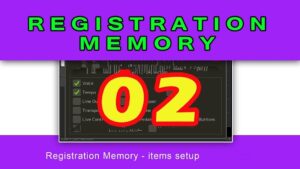 The Kawai CA501 has another feature that I really like which some digital pianos have and some don’t. For people who would use many of the features & functions I have already discussed and they like to change and edit things and enjoy using the variety of digital technology in this model, then being able to “save” your customer settings would be important. This is because you don’t want to have to re-create the special setup that you put together every time you want it.
The Kawai CA501 has another feature that I really like which some digital pianos have and some don’t. For people who would use many of the features & functions I have already discussed and they like to change and edit things and enjoy using the variety of digital technology in this model, then being able to “save” your customer settings would be important. This is because you don’t want to have to re-create the special setup that you put together every time you want it.RECORDING & PLAYBACK

 You can save ten 2-track MIDI recordings within the internal memory of the CA501 and also save those recordings along with audio recordings to a USB thumb-drive for quick playback to hear the songs you recorded. You can playback the MIDI songs files at any speed while listening to or learning how to play that song. You can also set “repeat loops” so the song player will only play back any part of the song that you choose and continually repeat (loop) it for practice sessions. You can also adjust the speed of that looped song part to play along and better learn it at a slower speed. That’s a very cool feature.
You can save ten 2-track MIDI recordings within the internal memory of the CA501 and also save those recordings along with audio recordings to a USB thumb-drive for quick playback to hear the songs you recorded. You can playback the MIDI songs files at any speed while listening to or learning how to play that song. You can also set “repeat loops” so the song player will only play back any part of the song that you choose and continually repeat (loop) it for practice sessions. You can also adjust the speed of that looped song part to play along and better learn it at a slower speed. That’s a very cool feature.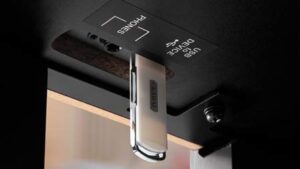 You can change settings during the recording process as well as transpose key and other aspects of the music. If you record a song in the 1 or 2 track MIDI format and want to save that song as an audio song file, you can do that conversion easily within the CA501 by converting the saved song into a WAV file or MP3 file and then save the file onto a USB memory stick and save it to your home computer. Many digital pianos have USB memory stick features to save and playback recordings, so it is not uncommon. But it is definitely more unusual to be able to record, playback, and overdub in all 3 file formats…MIDI, MP3, and WAV like the CA501 can.
You can change settings during the recording process as well as transpose key and other aspects of the music. If you record a song in the 1 or 2 track MIDI format and want to save that song as an audio song file, you can do that conversion easily within the CA501 by converting the saved song into a WAV file or MP3 file and then save the file onto a USB memory stick and save it to your home computer. Many digital pianos have USB memory stick features to save and playback recordings, so it is not uncommon. But it is definitely more unusual to be able to record, playback, and overdub in all 3 file formats…MIDI, MP3, and WAV like the CA501 can.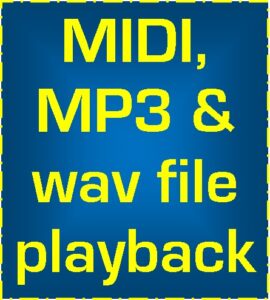 So when it comes to recording songs and playing them back, in my opinion the Kawai CA501 is very capable in this way and offers a variety of different recording and playback modes. It’s for beginners up through advanced players to learn songs, play along with songs, and do pro quality recordings of your music. I like the fact that the CA501 has both the audio WAV file and MP3 (iTune) recording formats and that you can add additional audio tracks to the recording through overdubbing. You can really make these recordings sound very professional.
So when it comes to recording songs and playing them back, in my opinion the Kawai CA501 is very capable in this way and offers a variety of different recording and playback modes. It’s for beginners up through advanced players to learn songs, play along with songs, and do pro quality recordings of your music. I like the fact that the CA501 has both the audio WAV file and MP3 (iTune) recording formats and that you can add additional audio tracks to the recording through overdubbing. You can really make these recordings sound very professional.BLUETOOTH WIRELESS STREAMING
 Bluetooth wireless connectivity is becoming more of a standard feature in many electronic devices including new digital pianos. There is Bluetooth audio streaming, Bluetooth MIDI wireless connectivity, Bluetooth digital page turning, and Bluetooth wireless headphones, among other things. In digital pianos there can be up to 3 different Bluetooth technologies, but wireless headphones is not one of them. Bluetooth headphones don’t work well in digital pianos because of inherent latency delays in the Bluetooth signal. So you won’t be able to use Bluetooth headphones in digital pianos until that technology gets more advanced in the future.
Bluetooth wireless connectivity is becoming more of a standard feature in many electronic devices including new digital pianos. There is Bluetooth audio streaming, Bluetooth MIDI wireless connectivity, Bluetooth digital page turning, and Bluetooth wireless headphones, among other things. In digital pianos there can be up to 3 different Bluetooth technologies, but wireless headphones is not one of them. Bluetooth headphones don’t work well in digital pianos because of inherent latency delays in the Bluetooth signal. So you won’t be able to use Bluetooth headphones in digital pianos until that technology gets more advanced in the future. As I was doing this Kawai CA501 review I noticed on the Kawai CA501 that the most useful Bluetooth wireless feature is the wireless audio streaming. This feature allows you to wirelessly stream music from your external device (phone, tablet, computer, etc) through the CA501 speaker system. When you do that them you can hear your favorite music from your personal music library in your device or music from YouTube videos, etc come through the CA501 speaker system so that you can use the CA501 as your “home stereo” along with being able to play the CA501 live along with the incoming streamed music so that you can learn those songs by playing along.
As I was doing this Kawai CA501 review I noticed on the Kawai CA501 that the most useful Bluetooth wireless feature is the wireless audio streaming. This feature allows you to wirelessly stream music from your external device (phone, tablet, computer, etc) through the CA501 speaker system. When you do that them you can hear your favorite music from your personal music library in your device or music from YouTube videos, etc come through the CA501 speaker system so that you can use the CA501 as your “home stereo” along with being able to play the CA501 live along with the incoming streamed music so that you can learn those songs by playing along.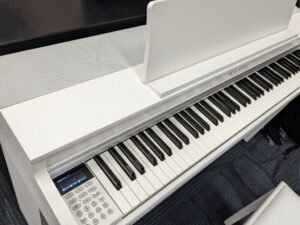 Also, when you plug in wired stereo headphones then all of the streamed music and your live piano playing go through your headphones for private practice and playing. Bluetooth audio streaming is a very practical way of hearing and playing along with music from your external devices and having it all coming through the digital piano. You can adjust the volume of the audio streaming with a Bluetooth audio volume control so that you can balance out the piano volume with the external audio volume.
Also, when you plug in wired stereo headphones then all of the streamed music and your live piano playing go through your headphones for private practice and playing. Bluetooth audio streaming is a very practical way of hearing and playing along with music from your external devices and having it all coming through the digital piano. You can adjust the volume of the audio streaming with a Bluetooth audio volume control so that you can balance out the piano volume with the external audio volume.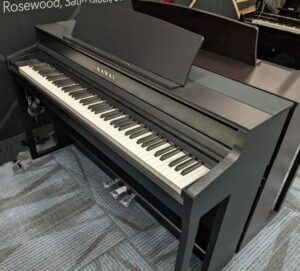 Another aspect of Bluetooth is a wireless MIDI-USB connection. Normally you would use a USB cable to connect an external device to the piano so that you could interface with an external MIDI-USB device. A cable works fine and gets the job done. But if you don’t want any cables because of the “look” of your device resting on the music rest with a cable plugged in or because you just want to reduce cable connections, then you can connect the CA501 to another USB device for wireless MIDI connectivity. You can only use one Bluetooth connection at a time and it can be useful in different situations. The Bluetooth connectivity and controls for the CA501 do work well and can assist you with your music creativity.
Another aspect of Bluetooth is a wireless MIDI-USB connection. Normally you would use a USB cable to connect an external device to the piano so that you could interface with an external MIDI-USB device. A cable works fine and gets the job done. But if you don’t want any cables because of the “look” of your device resting on the music rest with a cable plugged in or because you just want to reduce cable connections, then you can connect the CA501 to another USB device for wireless MIDI connectivity. You can only use one Bluetooth connection at a time and it can be useful in different situations. The Bluetooth connectivity and controls for the CA501 do work well and can assist you with your music creativity.SPATIAL HEADPHONE SOUND
When it comes to digital (non-acoustic) pianos, one of the more practical aspects of them is to be able to play and practice silently by using headphones. Just plug in a pair of headphones and play and no one else will hear you. For some people that is an important feature and very important. It’s especially important if you live in an apartment building with neighbors who are close by, or you want to play late at night, early, in the morning, or you want to play piano when other things are going on in the home and you need it to be quiet.


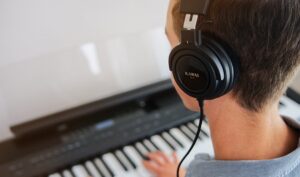 All of this means that if you are going to be using headphones the Kawai CA501 will also improve that experience for you. For young children who would be using headphones, these features would not necessarily be important because all they need in the beginning is just to practice privately with any headphones. But eventually quality and realistic sound through a good pair of headphones will be important and the CA501 has the features it takes to help make that happen, and it does work and sound good that way.
All of this means that if you are going to be using headphones the Kawai CA501 will also improve that experience for you. For young children who would be using headphones, these features would not necessarily be important because all they need in the beginning is just to practice privately with any headphones. But eventually quality and realistic sound through a good pair of headphones will be important and the CA501 has the features it takes to help make that happen, and it does work and sound good that way.CONNECTIVITY HARDWARE
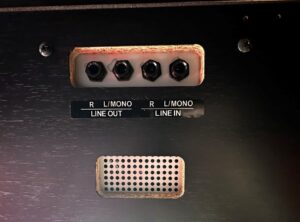 Being able to connect external devices and external speakers to a digital piano can be important for some people depending on the purpose for wanting to do that. The Kawai CA501 has the hardware connectivity built in to it that most people want. This includes dual 1/4″ professional audio outputs, dual 1/4″ professional audio inputs, dual headphone jacks including a 1/4″ stereo jack and one stereo mini-jack, a USB port to host (computer, tablet, etc), and a USB thumb-drive port. the ports. The jacks are located underneath the piano but they are easily accessible.
Being able to connect external devices and external speakers to a digital piano can be important for some people depending on the purpose for wanting to do that. The Kawai CA501 has the hardware connectivity built in to it that most people want. This includes dual 1/4″ professional audio outputs, dual 1/4″ professional audio inputs, dual headphone jacks including a 1/4″ stereo jack and one stereo mini-jack, a USB port to host (computer, tablet, etc), and a USB thumb-drive port. the ports. The jacks are located underneath the piano but they are easily accessible.
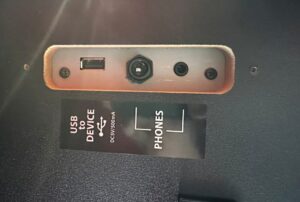 Having this connectivity interface in the CA501 means gives you a lot of flexibility. You can not only easily connect the CA501 to an external speaker system for a big venue, church, school, etc, but you can also connect external audio devices into the CA501 such as an iPad, phone, etc and use the CA501 as an external speaker system for those devices. You can plug in up to 2 sets of stereo headphones for private practice, you can save & load MIDI and audio song files into a USB thumb-drive for playback and storage, and you can connect the CA501 to an external device via USB output port. Also, as I already mentioned earlier, there is Bluetooth wireless connectivity built in to this model.
Having this connectivity interface in the CA501 means gives you a lot of flexibility. You can not only easily connect the CA501 to an external speaker system for a big venue, church, school, etc, but you can also connect external audio devices into the CA501 such as an iPad, phone, etc and use the CA501 as an external speaker system for those devices. You can plug in up to 2 sets of stereo headphones for private practice, you can save & load MIDI and audio song files into a USB thumb-drive for playback and storage, and you can connect the CA501 to an external device via USB output port. Also, as I already mentioned earlier, there is Bluetooth wireless connectivity built in to this model.USER INTERFACE CONTROL PANEL
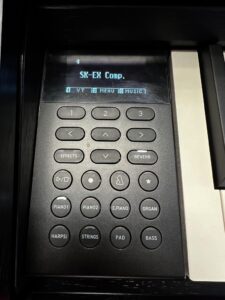 The Kawai CA501 has a completely redesigned user control panel with digital display screen that was not on previous models. This user button driven interface is more tactile, easier to use, more intuitive, and the display screen is easier to see than before with OLED light technology. Sometimes it’s preferable to have buttons on the control panel to operate the features and functions as opposed to a touch screens that are on some higher priced models. So it just depends of the user interface itself, the size of it, and the layout.
The Kawai CA501 has a completely redesigned user control panel with digital display screen that was not on previous models. This user button driven interface is more tactile, easier to use, more intuitive, and the display screen is easier to see than before with OLED light technology. Sometimes it’s preferable to have buttons on the control panel to operate the features and functions as opposed to a touch screens that are on some higher priced models. So it just depends of the user interface itself, the size of it, and the layout.KAWAI “PIANO REMOTE” APP
 For some people out there who have external devices like phones and tablets (iPad, Android, etc) and would prefer to use those devices to control functions & features of a digital piano, Kawai has an impressive and easy to use app for those devices which they call “Piano Remote.” Piano Remote allows the user to select any of the 45 sounds in the CA501 by just touch that sound name from the color touch screen of your device. You can also select many of the other CA501 features from the app as opposed to selecting those features from the user interface in the CA501.
For some people out there who have external devices like phones and tablets (iPad, Android, etc) and would prefer to use those devices to control functions & features of a digital piano, Kawai has an impressive and easy to use app for those devices which they call “Piano Remote.” Piano Remote allows the user to select any of the 45 sounds in the CA501 by just touch that sound name from the color touch screen of your device. You can also select many of the other CA501 features from the app as opposed to selecting those features from the user interface in the CA501.INTERNAL SPEAKER SYSTEM
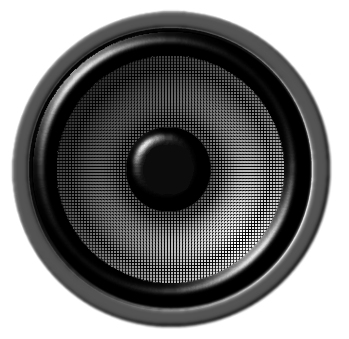 All furniture cabinet digital pianos from all the top brands have an internal speaker system. Internal speaker systems are vitally important because the piano sound engine in the piano can only sound good if the speaker system is good. Unlike a real acoustic piano where the sound is heard through the strings amplified by the wooden soundboard, a digital piano needs speakers and digital amplifiers to do that job. If the speakers and amplifiers aren’t good or powerful enough, the piano sound (and other sounds) in a digital piano can sound weak, tinny, artificial, and just not full and resonant.
All furniture cabinet digital pianos from all the top brands have an internal speaker system. Internal speaker systems are vitally important because the piano sound engine in the piano can only sound good if the speaker system is good. Unlike a real acoustic piano where the sound is heard through the strings amplified by the wooden soundboard, a digital piano needs speakers and digital amplifiers to do that job. If the speakers and amplifiers aren’t good or powerful enough, the piano sound (and other sounds) in a digital piano can sound weak, tinny, artificial, and just not full and resonant.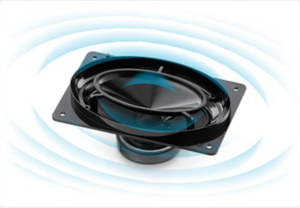 Beyond that, Kawai has included two sound diffusers on the top speakers, as I already mentioned, so that the sound is “diffused” or spread out in different directions as the sound is coming up and out of the top speakers. This sound dispersion helps the CA501 piano seem more natural because the sound is not just going in one direction, but instead the piano sound is going in multiple directions just like it would on a real acoustic grand piano. The speakers and speaker sound escapement ports on the top of the piano really open up the sound more and it seems to flow better.
Beyond that, Kawai has included two sound diffusers on the top speakers, as I already mentioned, so that the sound is “diffused” or spread out in different directions as the sound is coming up and out of the top speakers. This sound dispersion helps the CA501 piano seem more natural because the sound is not just going in one direction, but instead the piano sound is going in multiple directions just like it would on a real acoustic grand piano. The speakers and speaker sound escapement ports on the top of the piano really open up the sound more and it seems to flow better.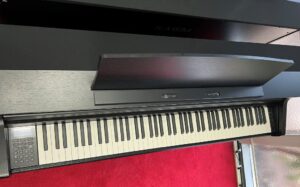 This type of speaker system design is an innovative one in my opinion and definitely sets the CA501 apart from the other digital pianos under or near $4000. Kawai designed the cabinet so that the top speakers are under an attractive grill cloth so the sound can more easily come out of the top of the piano and the entire CA501 cabinet still looks good.
This type of speaker system design is an innovative one in my opinion and definitely sets the CA501 apart from the other digital pianos under or near $4000. Kawai designed the cabinet so that the top speakers are under an attractive grill cloth so the sound can more easily come out of the top of the piano and the entire CA501 cabinet still looks good.FURNITURE CABINET DESIGN
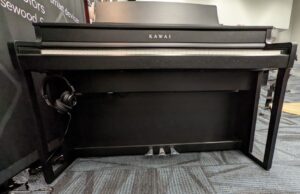 When it comes to producing a digital piano furniture cabinet, I personally think Kawai has come up with an attractive design that is sturdy and functional. It looks good from all angles and has a back privacy panel so that you cannot see through it. The front of the cabinet also has “support legs” to add to the stability of the cabinet.
When it comes to producing a digital piano furniture cabinet, I personally think Kawai has come up with an attractive design that is sturdy and functional. It looks good from all angles and has a back privacy panel so that you cannot see through it. The front of the cabinet also has “support legs” to add to the stability of the cabinet.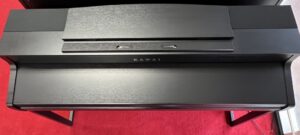 All of these upgrades and design changes are good to have in a digital piano. There is also a headphone hanger support hook for the piano so that you have a place to hang headphones under the piano should you be using them for private practice. The music rest/rack is a good size to hold sheet music & books, has multiple positions, and is nicely designed with simple lines to it. Every brand has their own unique cabinet designs and the Kawai piano company certainly did a good job on this one. The satin black and satin rosewood cabinet colors would be the most popular followed by the white cabinet finish
All of these upgrades and design changes are good to have in a digital piano. There is also a headphone hanger support hook for the piano so that you have a place to hang headphones under the piano should you be using them for private practice. The music rest/rack is a good size to hold sheet music & books, has multiple positions, and is nicely designed with simple lines to it. Every brand has their own unique cabinet designs and the Kawai piano company certainly did a good job on this one. The satin black and satin rosewood cabinet colors would be the most popular followed by the white cabinet finish Finally, you also get a matching standard height Kawai piano bench with the CA501 for the black, rosewood, and white cabinet colors, and it’s comfortable to sit on. I should know because I have sat on it. Some benches have music storage in them and some do not. But you do get some music book storage in this particular bench. This bench is not an adjustable height bench which some people prefer. But…it’s a good bench and should comfortably support different size people. However, a matching height adjustable bench comes with the new Mocha color cabinet, but it does not have music storage in it.
Finally, you also get a matching standard height Kawai piano bench with the CA501 for the black, rosewood, and white cabinet colors, and it’s comfortable to sit on. I should know because I have sat on it. Some benches have music storage in them and some do not. But you do get some music book storage in this particular bench. This bench is not an adjustable height bench which some people prefer. But…it’s a good bench and should comfortably support different size people. However, a matching height adjustable bench comes with the new Mocha color cabinet, but it does not have music storage in it.FACTORY WARRANTY
FINAL THOUGHTS
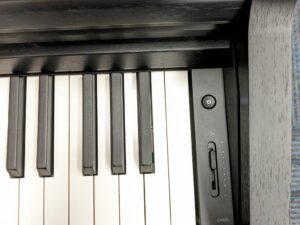 The new Kawai CA501 is a winner in my book. It does what most people want a digital piano in this price range to do…and that’s give them the best piano playing experience they can get in this price range. Having the most authentic and most organic piano playing realism is, by far, the most important thing when getting a new digital piano. The “bells & whistles” are great to have, but not at the expense of piano playing realism and authenticity.
The new Kawai CA501 is a winner in my book. It does what most people want a digital piano in this price range to do…and that’s give them the best piano playing experience they can get in this price range. Having the most authentic and most organic piano playing realism is, by far, the most important thing when getting a new digital piano. The “bells & whistles” are great to have, but not at the expense of piano playing realism and authenticity.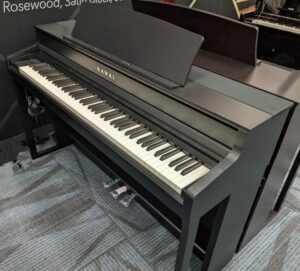 But if you can be in an intermediate price range then you’ll get a more advanced level piano playability with this model, The Kawai CA501 will impress you in that way and will likely be all you will ever need, unless you are able to be in a higher price range and get the Kawai CA701 which sells for $5049. I have done a review of that model in another review post. There are other good digital piano brands in this general price range as well as below and above this price like the CA701, and I have played them all.
But if you can be in an intermediate price range then you’ll get a more advanced level piano playability with this model, The Kawai CA501 will impress you in that way and will likely be all you will ever need, unless you are able to be in a higher price range and get the Kawai CA701 which sells for $5049. I have done a review of that model in another review post. There are other good digital piano brands in this general price range as well as below and above this price like the CA701, and I have played them all.


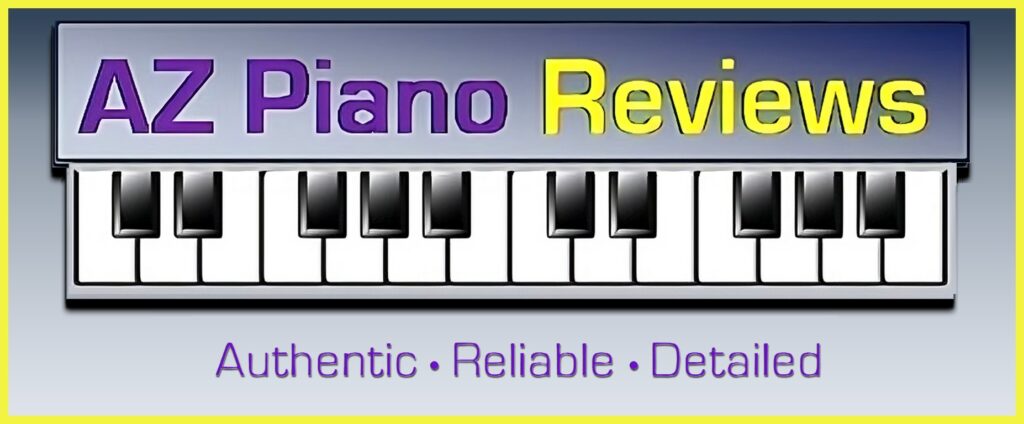

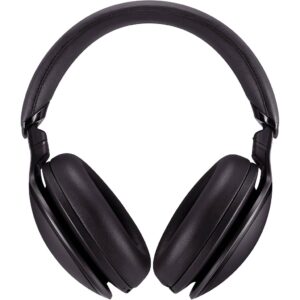



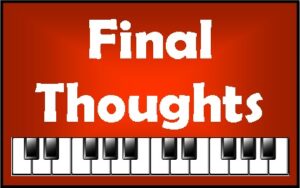



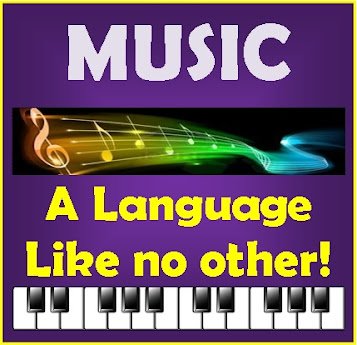

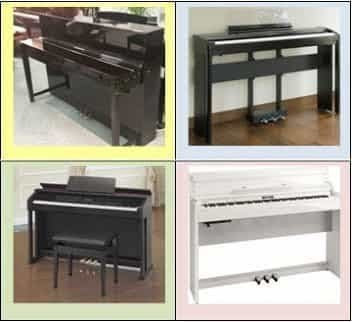




I appreciated your thorough review of this piano but I can't find any reviews from pianists who have actually bought the Kawai CA501 digital piano. This concerns me because it looks like many people have bought them since there are waiting lists for it at some stores. I wish I could find several more opinions on it before I spend such a large amount for a digital piano. I'd appreciate any other insight you may have about this. Thanks!
I purchased the Kawai CA501 piano last year around April timeframe. The piano is awesome and looks great. I purchased through the owner of this website and received a tremendous deal, which included free shipping, no taxes, and a healthy percentage off the list price. Perfect in every way. It will take several years for me to fully appreciate all the features of this instrument. I love it!
Really good review! Keep up the good work
Yamaha Clp 745 VS Kawai CA 501, which one to choose?
Although the Yamaha CLP-745 digital piano is an impressive digital piano, the "longer key all-wood" key action in the Kawai CA501 is noticeably more sophisticated and realistic in every way as compared to the CLP-745. Therefore if the realism and authenticity of the piano playing experience is most important to you then the Kawai CA501 would be the better choice. The piano sound realism and pedaling response is also impressive on the CA501.
I’m curious if you prefer this CA501 over Casio’s GP310?
I like both models very much but they are so different from each other. Personally, I would choose the Kawai CA501 over the other one because it, overall, offers more music/piano related features and functions along with an impressive piano playing experience.
Thank you for very detailed and helpful reviews!
I am choosing between CA401, CA501, CN-201 and CN-301, which one would you recommend for a beginner? Key action is more important for me than variety of digital features. I went to the showroom and tried CA501 and CN201/CN301 (the did not have CA401, but CA501 must feel the same?) but could not decide which keys felt better.
Also there is a big price difference between CA501 and CA401, does it worth it?